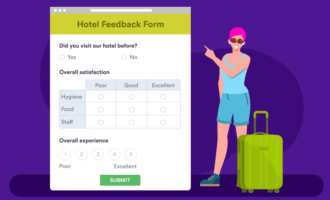Surveys can be powerful tools to better understand your market, customers, and employees. But a survey is only as good as the data it provides. If you have a poor survey response rate or the data is unclear, you might not get as much use out of the information as you had hoped.
There’s a science to survey development. Keeping an eye on your response rate can help you assess your survey’s effectiveness. Read on to find out what qualifies as a good survey response rate for your business — and how to improve your response rates.
What exactly is a survey response rate?
Your survey is likely a series of questions that you ask a target group to answer. Your goal is to get a large number of people to thoughtfully complete the survey.
When someone completes a survey, it is recorded as a survey response. The survey response rate tracks the percentage of people who complete the survey compared to the number of people who see it.
Why is the survey response rate important?
Your response rate provides information on how engaged your audience is in providing feedback. If there’s low interest in your survey or the questionnaire is too complicated, you won’t get the data you want.
“Your survey response rate is the number of customers who actually take the time to respond to one or more questions and submit the survey, relative to the number of customers asked,” writes Rachel Wolff at text analysis platform MonkeyLearn. “The higher your response rate, the better — a higher survey response rate indicates less possible bias, and therefore more confidence in your results.”
This reasoning is akin to how you evaluate online reviews of businesses before you choose one to buy from. A restaurant with 4.5 stars and 1,000 reviews has more reliable data than a restaurant with 5.0 stars and three reviews. There are more people recommending the first restaurant and likely responding honestly.
By working toward a higher response rate when you design your survey, you’ll increase the chances that more people will respond to it, and by extension, you should get higher-quality data.
What does an average response rate look like?
Every survey and audience is unique. Some companies may have high survey response levels, while others struggle to attract people to answer their questions. However, there are some industry best practices you can follow.
The team at the Digital School of Marketing says a survey response rate higher than 50 percent is considered excellent. Most survey response rates range from five to 30 percent, and the rate often depends on who’s conducting the survey and what — as well as how many — questions they’re asking. For example, if you expect customers to fill out a 10-minute survey, they may get tired or bored and give up halfway through.
But your goal with creating a survey is also to get high-quality answers, not just a high number of responses. One organization realized that forcing employees to complete surveys was resulting in terrible data quality.
“We recently realized that one of the companies with the lowest engagement scores…had a 100 percent participation rate,” says Jason McPherson, founding scientist at employee experience platform Culture Amp. “In fact, a 100 percent participation rate can be a bad sign, as it’s usually accompanied by comments about coercion and a large number of missing responses or unmeaningful responses.”
By forcing people to take surveys, companies often receive more negative answers and poor ratings. Respondents simply answer the questions without actually thinking about them.
What can you do to improve your response rates?
If your survey response rate is lower than you’d like, you can take steps to improve how people engage with your questions. Here are a few tips:
- Ask fewer questions. Respondents can get bored easily with long surveys.
- Use simple questions types, like multiple-choice. No one wants to write long essays about your business.
- Include a progress bar so your respondents know how far into the survey they are.
- Avoid asking the same questions, just slightly tweaked, multiple times. Your audience will get frustrated.
- Make sure you choose an opportune time to ask for survey responses. You might not get good results over holidays or during periods when your customers or employees are busy.
Additionally, digital marketer Kristy Hartman encourages survey builders to offer incentives to people who complete surveys. These could be coupons for future purchases or cash gifts for offering feedback. “Even a five-question survey takes a commitment to complete, and the reward value needs to be commensurate with the amount of time that is required from the respondent,” says Hartman.
What makes Jotform great for surveys?
As you develop a deeper understanding of how to create effective surveys, look for tools that provide the features that you need.
Jotform has thousands of free survey templates, so you can spend less time building questionnaires and more time reaping data from responses. Other features include advanced customization options, such as conditional logic for interactive surveys, and mobile-friendly tools for surveys on the go.
Learn more about these features and how you can use them in your surveys.
Photo by SOCIAL.CUT on Unsplash






































































































Send Comment: